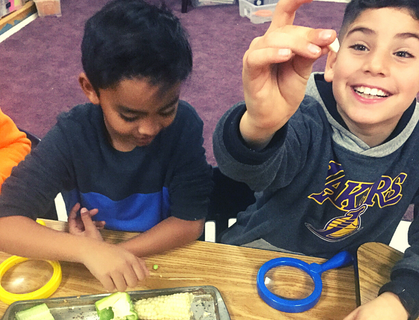Project Based Learning at VCES
Overview of Project Based Learning
Bringing the Standards to Life
Project based learning is one of the “best practices” that VCES teachers follow when building and planning curriculum. Project based learning (PBL) is a teaching method in which students learn by actively engaging in real-world and personally meaningful projects. Students create, plan, build, and work collaboratively as they answer driving questions that are at the foundations of the project. When students actively engage with information, ideas, and problems, their conceptual understanding becomes more sophisticated and meaningful, and retention is high.
VCES’ Project Based Approach Builds a Love of Learning and a Strong Academic Foundation
An alum parent reflects on how hands-on learning at VCES helped her sons thrive in high school.
"As a parent at VCES, I have incredible gratitude for the level of nurturing and care my boys, Jacob and Zachary, received from all of the teachers. VCES provided a holistic approach to learning, always addressing not only the educational needs of the child, but also their psychosocial development. Project-based learning helped my boys think outside the box, become creative and critical thinkers, and develop a genuine love of learning. Jacob and Zachary are happy, well-adjusted, and curious learners because of Valley Charter.
When my boys first transitioned to high school, I was concerned that their K–8 public school education might not measure up to the demands of a private high school, and that they would fall behind. However, this was far from the case. Both of my boys have made the Dean’s List every semester and have thrived both socially and academically. I am convinced that the supportive environment, small class sizes, and exceptional teachers at VCES laid the foundation not only for academic success, but also for the social and emotional well-being that will support our boys for years to come. Thank you, Valley Charter—we truly won the lottery when our family was selected for VCES!"
-Beth Kautzky, VCES Parent (Classes of '18 & '20)
Implementation of PBL in VCES Social Studies and Science Curriculum
VCES teachers use the project based learning model while delivering the California state social studies and science standards. The projects that VCES teachers create frequently evolve each year to suit the needs and interests of that particular group of students, while still aligning with the state standards.
PBL Case Study: 2nd Grade Community Project
Community: Los Angeles
CA state standards addressed:
- 2-LS4-1. Biodiversity and classification of plants and animals
- 2.2 Map skills: directionality, how to read a map
- 2.3 United States government functionality
- 2.4 Basic economic concepts
Driving Question: (The real-world concept to which the standards connect)
- As community planners, how do we build a city that allows us to live in harmony with the plants, animals and terrain around us?

This 2nd grade "community board" is the result of a year spent working through the driving question.
Description
In this interdisciplinary yearlong project, 2nd grade students explore what it means to live in balance with the natural environment while building a functional, sustainable community. Anchored in science and social studies standards, this project integrates biodiversity, mapping, civics, and economics. Through collaborative lessons and hands-on experiences, students take on the role of community planners—researching ecosystems, designing civic structures, analyzing local needs, and proposing solutions that reflect environmental and social responsibility.
Lessons and Activities
1. Map Work: Understanding and Mapping Earth’s Surface Features
- Question: If you floated down a river, where would you end up?
- Discussion: Why is there sand at the beach?
- Research: What’s strong enough to make a canyon?
- Activity: Make a map with topographical features (see pictures below).




2. Classroom Election for Community Mayor
-
Discussion: Who gets to be in charge of a community?
- Activity: Mayoral election (2nd graders decided to use the Kevin Henkes mice characters as nominees for mayor.)
- Students nominated characters from the Kevin Henkes books, wrote a persuasive piece, and made speeches to their classmates to win votes.
- Then they cast their ballots in classroom voting booths.




3. "Critter books": Animal Biodiversity, Classification, Habitats and Engineering
- Discussion: How many different kinds of animals are there?
- Field trip to the Arboretum: Students made notes in their critter books as they observed animals.
- Discussion: Why do frogs say ribbit?
- Experiment: Design a bird feeder that successfully feeds the most birds.
- Field trip: Arboretum field trip to research animal classification in critter books.





4. Student Garden: Plant Biodiversity and Classification
- Discussion: How does it benefit everyone when communities grow their own food?
- Activity: Replicate victory gardens in the class model community and learn when to plant specific plants.
- Activity: Students sold produce they grew in the garden.




